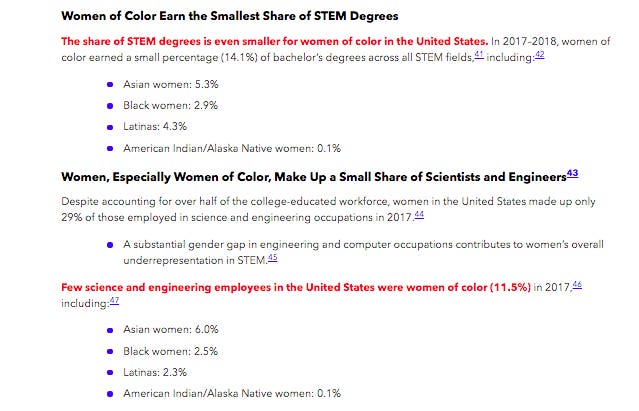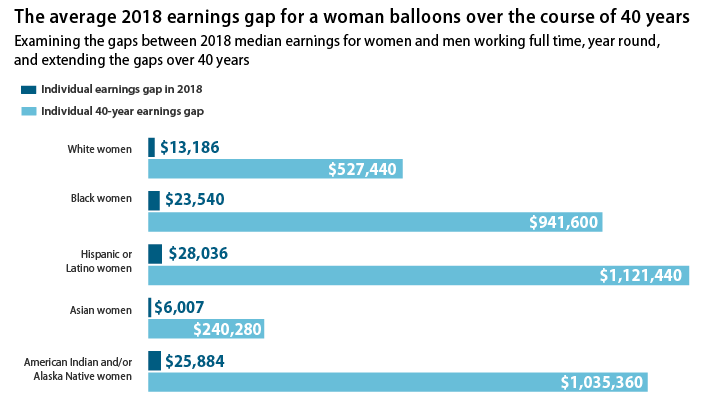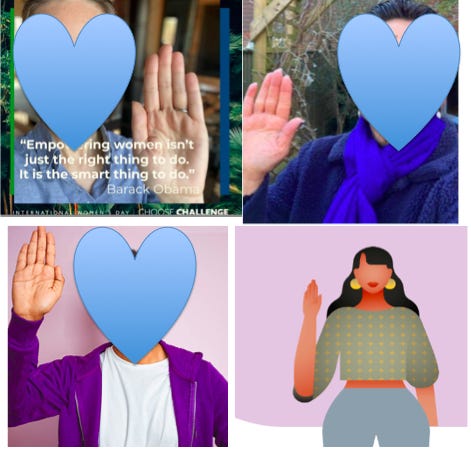I nternational Womens Day & Why Performative Allyship Makes Me Mad
On misogyny, gender pay parity, political party symbols and hashtags in this pandemic
Oh, hi, hi!
I didn’t say you’ll be comfortable reading my little irregular newsletter, did I? 🙂
So yesterday was International Women’s Day, and suddenly the world was filled with allies, and supporters of women everywhere. Especially in biotech. I say this half-seriously, because while women in science are very excited to have allyship, where the heck were you all this while, my people? Am I asking the cis/hetero men this question? Not really—we really are happy you’re with us. But more importantly, I’m asking this of the other women in the workplace in leadership positions who have been ambitiously reached those leadership roles.
At a women in science symposium in Boston, I spoke about the ‘crab syndrome’ and all the women laughed uneasily. Because who wants to be told about crabs (insert insensitive pubic lice joke here). “Crab Syndrome”, for those who may be unfamiliar with the term is the phenomenon of crabs when placed in a bucket, try to climb out and other (crabs) pull them back in. Fishermen noted that they leave the buckets open, because the crabs keep each other inside the bucket. When we apply it to humans, it is the “if I can’t get it, nor should she” phenomenon. It is insidious, demoralizing and ultimately it’s not good for anyone.
Let me science it for you some
I see this a lot in the science world. So let me science you some more. Here’s some STEM data on women, their degrees and the % of them:
Reference: https://www.catalyst.org/research/women-in-science-technology-engineering-and-mathematics-stem/
Now, let’s talk about women of color in STEM (you knew I’d be going there, didn’t you?)

Before I science you out, here is what I am saying: Over 50% of degrees in science, especially higher level education is by women. But when they are employed, the numbers fall drastically. Just three years ago, BIPOC women made up less than 12% STEM employees. So where do they go? What do they do? Why do they study so hard and give up when they’re so close to changing the status quo?
Let’s talk money, shall we?
Again, I am predictable, am I not? Yes, ultimately it’s about money. Because money makes life much easier for a whole lot of us. We aren’t in a capitalist society to pretend otherwise, so let’s be straight with each other. You can talk philosophy, and giving to others and being your beautiful charitable self, only if your belly is full, your health insurance doesn’t give you sleepless nights, and you have a home, a car and all amenities that let you be your beautiful charitable self.
So, what do women in STEM earn when it comes to $$$ in the US?

But so what? It’s just a few cents, isn’t it? Okay, let’s science you some more. Here is what women of different ethnicities will lose over their 40-year earning lifetime.

Oh, but Madhushree, look, Asian women have the least pay gap, and you’re Asian so you should be fine.
I bet that’s what you’re thinking, aren’t you? Well, my dears, you just demonstrated the crab syndrome. The point is to fight for equal pay for equal work for all. By all, this means women, men, transgender, people of color, everyone. Which part of ‘everyone’ did you miss?
Lend a hand, don’t be a dick
This is where women leaders come into play. If you are white, cis-female, and in a leadership role, this should be a part of you. Lend a hand. Don’t be a dick. You wouldn’t have reached this level if you didn’t have the privilege of being where you are through your connections, your mentors, your guides, your education and your status in society. It’s a fact. Women of color who are leaders—the same rules apply. And this is where the performative actions come into play. When you stand behind a sign of #diversity, #womensupportingwomen and all that—do it, help each other. Mentor. Guide. Coach. Talk to them. Tell them which course/training/class you took. Tell them how to improve themselves. Introduce them to your LinkedIn groups. Listen. And, most importantly, do it for free. Do it because it’s the right thing to do. Do it because good things, just like bad things, will come back to bring you joy. I promise you.
Okay, back to talking about IWD
So, like the title of this piece says, I’m mad. But before that, let me tell you about IWD. IWD was celebrated for over a 100 years and then, get this, then FADED around 2000, because “feminism wasn’t popular anymore”—erm, what? Feminism isn’t a flavor of the month, dears. Some of us fight because that’s the only thing left for us to keep the others from running all over us. Most of us fight for others, and IWD told us pretty much that. Gloria Steinem noted, “The story of women’s struggle for equality belongs to no single feminist, nor to any one organization, but to the collective efforts of all who care about human rights.” While the newer generation has been painstakingly aligning women’s rights to human rights, women’s rights to climate change, to animal rights, it’s been a long ride and the journey is still ongoing.
So yesterday, IWD pushed for hashtags. Folks took selfies, with their hand held up, palms facing camera. The hashtag was #ChoosetoChallenge —that we will will call out gender stereotyping, discrimination, celebrate women’s choices, successes and joys and ensure women everywhere are given the respect they deserve. Very apt. Very needed. Very important.
But here’s the deal. Why do we have to call it out? Why do WE, we the women have to remind the rest of the world, AGAIN, that this is happening? Just like during BLM, everyone asked Black people to do THEIR work for them— “Tell me how I can help. Tell me what I should do. Tell me your story, so I can help you.” —instead of working to learn and educate themselves. I feel women are exhausted. We don’t need to also exhaust ourselves having to explain how we have been marginalized, erased and gaslit. In life, in science, in our workplaces.
I wrote about this in DAME magazine about Ellen Pao. Where she became a reticent crusader for gender pay parity and workplace harassment and was character-assassinated. Even now when the Silicon Valley people talk about Pao, it is a “It was the right case, but the wrong person,” again vilifying the victim. This is more than #metoo in my opinion. I should NOT have to raise my hand and promise to call out discrimination. I have been doing it for decades. You, YOU, with your hand up promising, had BETTER keep your promise because if not, this is politics and this is performative.
Here are some of these images on LinkedIn that got my goat (faces hidden for obvious reasons).
Oh, but Madhushree, they’re so earnest, so sweet. Look at them promising good things and using Barack Obama quotes. You’re mean, and vicious and you hate people.
Yes, that may be true. But here is the deal—raising your hand up like that reminds me of a salute in Europe in the 20th century that wasn’t a pretty promise and continues to raise its ugly head globally. Most recently, this palm raised, became a salute at the Capitol on January 6th, 2021. Raising your hand like that reminds me of politics in a country that was run by a woman who managed to establish Emergency rule, imprison her political opponents, censor the press and egregiously violate human rights.
The hand sign is performative. It is a hello, a hi, a promise. It’s benign. And then it isn’t.
Don’t believe me? Here is what the first female Indian Prime Minister’s party—a party I question daily—this is Indira Gandhi’s political party sign.

So don’t tell me IWD’s hashtag challenge is an earnest promise. That all these people will do the work. They will do it, but they can leave this symbolism aside when the real work commences. Just know—this isn’t what will get women their due. We will. And for that, work needs to be done.
And now, books
Okay, here’s what I am reading and I hope that you take a look at them too. I’ll talk more books next time, I promise. I try and then shit like this hand symbol comes up and there I go, what can I say!
-
Sonia Faleiro’s The Good Girls is an outstanding piece of reportage and a writing style that is mindblowing. As noted in the book review on New York Times, by Nina Burleigh, “Sonia Faleiro set out to examine India’s rape culture, but what she ended up revealing was something even more mundane and terrifying.”
-
The second one, out this Spring 2021, from UGA Press is debut author Anjali Enjeti’s spectacular essay collection that I’ve talked about ad nauseum. Southbound: Essays on Identity, Inheritance and Social Change will be out in a few weeks and my interview with her will also be published soon—I’ll send you links shortly. I love her work, her activism and her nuanced questioning of what a name means to someone with Indian roots, what it means to grow up brown in the Deep South, where activism comes from and where is it headed.
I strongly recommend you buy these books if you can, and if not, borrow from the libraries who are our best friends anyway.
Tell me your IWD story. How was it? Did you feel good with your promise? Tell me why you think I’m wrong—I love a debate!
Okay, once again, too long of a newsletter, but this isn’t #girlgab for nothing!
Stay well, stay strong, the vaccine is here.
Hugs,
M


